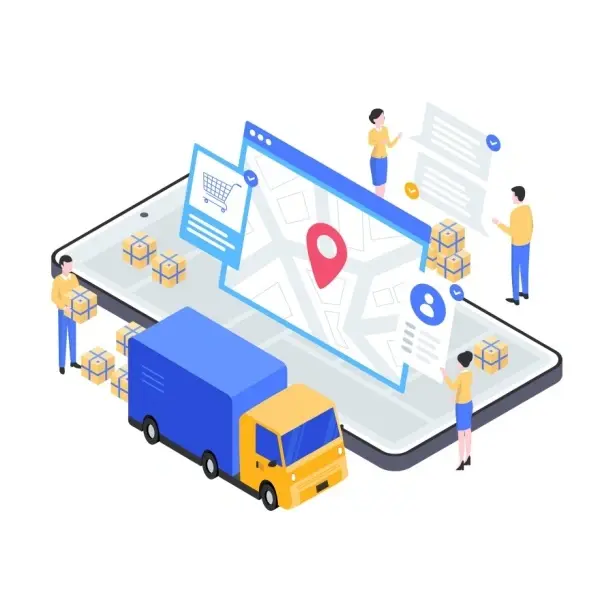Asset tracking has evolved from being perceived as a luxury to being recognized as a necessity in today's competitive business landscape. Initially, businesses viewed asset tracking as a luxury, primarily reserved for large corporations with extensive fleets or inventories. However, as technology has advanced and the business environment has become more complex, asset tracking has become essential for businesses of all sizes and industries. This transition has occurred in part due to the technology’s ability to enhance operational efficiency, mitigate risks, ensure compliance, meet customer expectations, and more. As businesses continue to evolve and the market becomes more competitive, asset tracking will remain a critical tool for success and only grow more critical as businesses choose to invest in AI and other data-reliant innovations. Let’s break down why investing in asset tracking is no longer an option but a strategic imperative for businesses looking to thrive in today's dynamic business environment.
Increase Your ROI by Investing in AirFinder Everywhere
- Loss Prevention. Reduce the amount of loss that occurs during the supply chain process
- Location Coverage. AirFinder Everywhere uses a combination of GPS, Cellular, and WiFi to determine location everywhere
- Security Alerts. Know when a delay in shipment has occurred so the problem
can be addressed immediately.
The Evolution of Asset Tracking and Its Uses
Asset tracking has undergone significant evolution over the years. From manual record-keeping to advanced cloud-based solutions, the methods and technologies used for asset tracking have continuously evolved to meet the growing needs of businesses. By examining how asset tracking has evolved over time and why each subsequent version was pursued, we can reveal the reasons that companies want access to asset tracking in the first place. This, in turn, can help us demonstrate whether asset tracking solutions are a luxury or necessity. But first, let's explore the journey of asset tracking through its various stages of development.
Manual Record-Keeping
Manual record-keeping was one of the earliest methods used for asset tracking. In this method, businesses maintained physical records, such as spreadsheets or other strategically organized paper-based logs, to track their assets. While this approach provided a basic level of tracking, it was labor-intensive, prone to errors, and lacked real-time visibility into asset movement. Still, it was a good place to start, providing a somewhat reliable method for keeping track of the assets that a company had at their disposal, where they were being stored, and how they were being used.
Barcoding and QR Codes
The introduction of barcode and Quick Response (QR) codes revolutionized asset tracking by enabling a basic level of automation for the data capture and retrieval processes. Assets were assigned unique barcode or QR code labels, which could be scanned using handheld devices or smartphones equipped with specialized scanning apps. This method significantly improved efficiency and accuracy in asset tracking, allowing for faster identification and inventory management. However, although an improvement of fully manual record-keeping, it remained limited and labor intensive, requiring manual scanning and not providing visibility for lost or misplaced items.
Radio Frequency Identification (RFID) Technology
RFID technology brought about a new era in asset tracking by enabling wireless, contactless identification and tracking of assets. RFID tags, equipped with microchips and antennas, transmit data to RFID readers via radio waves without the need for manual scanning that barcodes and QR codes rely upon. This technology allows for real-time tracking of assets within a designated range, without the need for line-of-sight or manual scanning. Although its range is limited, potentially resulting in incomplete data or lost assets, it functions as a natural development and expansion on preceding technologies.
GPS-Based Tracking Systems
The advent of GPS-based tracking systems introduced a new level of precision and accuracy to asset tracking. GPS technology leverages satellite signals to determine the exact location of assets in real time, both indoors and outdoors. This is especially valuable for tracking mobile assets, such as vehicles and equipment, across large geographic areas. GPS tracking systems provide businesses with comprehensive visibility into asset movement, enabling better route optimization, theft prevention, and asset recovery. And unlike the preceding methods, GPS tracking is a method that can truly offer full visibility without manual input beyond basic system set-up, saving more time and money than ever before.
Internet of Things (IoT) Integration
The development of asset tracking technology has not, however, stopped at the onset of GPS and other modern location technologies. Instead, the increasing integration of asset tracking with the Internet of Things (IoT) has further transformed the way assets are monitored and managed. IoT-enabled sensors embedded in assets collect and transmit data to centralized platforms via wireless networks. This data is not limited to location, also including real-time monitoring potential for conditions temperature, humidity, vibration, and more, allowing businesses to gain valuable insights into asset health and performance. This allows for improved analytics and predictive forecasting, as well as the real-time monitoring of sensitive goods.
Why Asset Tracking Has Become a Necessity
When the earliest forms of asset tracking were first developed, it was with the goal of making daily processes easier and more efficient for the people conducting and overseeing those processes. By keeping consistent records of the movement of assets throughout a facility or operational process, companies could achieve a consistency that was not possible otherwise. As the years wore on and the industries and the technology supporting them changed, asset tracking systems only became more critical to conducting business successfully, in a way that fuels ongoing growth. The circumstances of the logistics industry and the supply chain are not what they once were, and those circumstances have truly made asset tracking a necessity for any company that wants to survive and thrive in the modern market. Some of the reasons that these solutions are more necessary now than they ever were before include:
1. Businesses are working at increased capacities
As businesses expand their operations and manage larger inventories, the complexity of tracking assets grows significantly. With more assets to monitor, businesses need to ensure accurate inventory management and prevent losses. Effective asset tracking allows them to keep track of their inventory levels, monitor stock movements, and ensure that they have the right amount of inventory on hand to meet customer demand. These systems also help companies monitor a greater number of assets over a wider range, as its automated, highly accurate nature means that it's easier than ever before to track critical assets with increased efficiency.
2. Businesses are dealing with labor shortages
Many industries are currently experiencing labor shortages, which can impact the workforce available for asset management. Asset tracking solutions can help businesses optimize their existing resources by automating manual tasks and reducing the need for human intervention in asset tracking processes. Further, by tracking the location and status of assets, businesses can improve resource allocation to deploy their workforce where it is most needed based on real-time data and demand projections. These systems can then ensure that the deployed workers are able to be productive, providing visibility for the key assets they require, reducing search times, and ensuring that equipment is properly maintained so that none of them are placed in danger.
3. The logistics market is becoming increasingly competitive
The logistics industry is highly competitive, with businesses constantly seeking ways to improve efficiency and reduce costs. IT asset tracking software provides a competitive edge by enabling businesses to track the movement of assets in real time, optimize routes, and improve overall logistics operations. In doing so, companies can both reduce costs and improve operational efficiency, allowing them to assign more resources to customer demands and improving turnaround times. This will help your company grow in reputation, giving your customers more reasons to remain loyal and more reasons to recommend your company and services to others.
4. The supply chain is becoming more unpredictable
Global supply chains face disruptions from various factors such as natural disasters, geopolitical events, and pandemics. These disruptions can lead to delays in shipments and affect the availability of crucial assets. Asset tracking helps businesses mitigate these risks by providing real-time visibility into the location and condition of assets, allowing for quick responses to changes in the supply chain. It also allows businesses to proactively identify potential risks and take measures to address them and minimize the impact. This can be done by referring to the data collected at similar points during the company’s operations. Asset tracking also lets companies address an unpredictable supply chain by providing tools for tracking inventory levels, letting them continuously assess their preparations for worst case scenarios.
5. Customers and regulatory bodies are demanding more transparency
Customers and regulatory bodies are increasingly demanding transparency in supply chains. They expect businesses to provide accurate and timely information about the origin, location, and condition of products. Asset tracking allows businesses to provide real-time updates on the status and location of assets, meeting these customer expectations. Asset tracking also helps businesses meet internal demands by providing detailed tracking information that can be shared with stakeholders to ensure transparency and accountability of the management process. This gives companies the trust and accountability they need to grow.
Why Asset Tracking is Only Becoming More Important
The necessity of asset tracking isn’t going anywhere anytime soon. In fact, the need for asset tracking is only growing as new technologies begin to take the stage. One of these innovative new technologies is AI, which is being used across industries to help improve predictive forecasting and other forward-thinking projections that can be used to improve a company’s chances of success in the modern market. However, AI can not function without a strong basis of data, and it cannot generate that data on its own.
Commercial asset tracking is becoming increasingly important for companies that want to implement AI in the future because it’s a quick, reliable way to generate the data that AI needs in order to function. By providing real-time data concerning the location, condition, and behavior of critical assets, companies can train AI systems to improve resource allocation, utilization, predictive maintenance, billing, stocking, and more based on what actually happens across their own unique cycle of business operations. This in itself will become a necessity in the future in order to remain competitive in an industry eager to implement these new AI-oriented business models.
Build the Asset Tracking Solution You Need
Just because asset tracking solutions are becoming necessities doesn’t mean that the asset tracking solutions that each business needs are going to be the same. Your company has plenty of needs and challenges that are unique to your operations, and it’s important to select an asset tracking system that can meet those needs in the way they need to be met. That’s why at Link Labs, we emphasize the importance of working with you to understand your business goals and asset tracking needs in order to ensure an investment in a system that will bring you the most advantages while staying within your budget. By combining a variety of location technologies, tags, and sensors, we’re able to deliver the solution that will help you pursue your company’s future success, no matter what that looks like. To get started, book a demo with our experts today.





